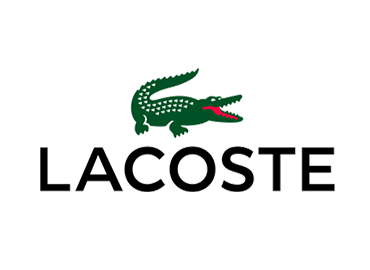"Contentserv's solution has been working perfectly for more than two years, and the objectives of this implementation have been achieved."
Jean-Philippe Dran
Chief Information Officer, Lacoste

Lacoste, a global icon of French elegance and sport-inspired fashion, boasts 10,600 points of sale worldwide, including 1,200 own-brand stores and 20 eCommerce sites across 120 countries. However, managing product data manually through Excel spreadsheets posed significant challenges, impacting accuracy and speed. With Contentserv, Lacoste transformed its approach, drastically accelerating market launches and optimizing product information across all e-commerce sites and points of sale, ensuring a cohesive brand experience that reflects the brand’s commitment to quality and innovation worldwide.

"Contentserv's solution has been working perfectly for more than two years, and the objectives of this implementation have been achieved."
Jean-Philippe Dran
Chief Information Officer, Lacoste

Since the creation of the first polo shirt in 1933, Lacoste has relied on the authenticity of its sporting roots to bring optimism and elegance all over the world thanks to its unique and original universe for women, men and children. Ambitious to be the benchmark player in high-end casual wear, the Crocodile brand is now present in 120 countries through a selective distribution network. Lacoste, managed since 2015 by Thierry Guibert, employs 10,000 people, has 10,600 points of sale, including 1,200 of its own branded stores, 20 eCommerce sites, and has a turnover of more than €2 billion.

Lacoste’s digital transformation aimed to expand the brand's omnichannel presence, evolving beyond the traditional model to deliver unique, premium shopping experiences across all sales channels. To guide this journey, Lacoste’s Digital Factory—a dedicated internal team—was established to uphold the brand’s “premium” identity while personalizing the customer journey. Building on solid systems like ERP, OMS, and DAM, they launched an e-commerce site to drive growth.
However, managing vast product data manually quickly became unsustainable. With 6,000 color references per season, multilingual updates, and the need to refresh collections every six months for different hemispheres, manual spreadsheet entry became a bottleneck. The result? Slow time-to-market, data inaccuracies, and missed sales opportunities.
Recognizing the need for a streamlined, scalable solution, Lacoste turned to Product Information Management (PIM) to reduce manual work, ensure accuracy, and accelerate time-to-market. With PIM, Lacoste could centralize and enrich product data efficiently, distributing it seamlessly across e-commerce and marketplace platforms—boosting agility and enabling the brand to deliver on its omnichannel ambitions.
Lacoste sought to deliver a unified, engaging experience across all sales channels, reflecting the brand’s premium quality and meeting modern consumer expectations. With a focus on enhancing e-commerce, Lacoste identified two measurable objectives: boost the average order value and reduce product returns. After evaluating five PIM solutions, Lacoste selected Contentserv in late 2016 for its user-friendly interfaces and robust experience in product information management.
Following a dedicated effort from Lacoste’s internal teams and support from Contentserv and partners, the PIM solution went live in November 2017. Beyond PIM, Lacoste implemented several integrated components: Translation Manager for effortless multilingual content, Salesforce Commerce Cloud Connector for seamless data transfers, Smart Documents for versatile document formats, and Workflow Manager for automated, visualized processes. Now, with 40 users managing data daily on the Contentserv platform, Lacoste’s teams have a comprehensive 360° view of products and can efficiently manage processes for diverse commercial sites.
Today, Lacoste’s IT team manages the platform in real-time, leveraging its expertise to support employees and maintain operations.
Contentserv’s PIM solution has empowered Lacoste with exceptional data management flexibility, handling 2.4 million attributes, 24,000 references, and 172,000 EAN/UPC barcodes seamlessly. With automated export processes, Lacoste can generate and update catalogs and web pages rapidly, supporting up to 40,000 item exports daily. Through intuitive drag-and-drop functionality, users can assemble product images, technical details, and pricing within pre-set templates.
Major gains also include drastically reduced time in creating new attributes—what once took months now takes just 2–3 weeks. Additionally, Contentserv’s solution streamlines seasonal reconfigurations by retaining attributes for ongoing products, eliminating the need for a full catalog rebuild every six months. This efficiency not only saves time but enhances Lacoste’s responsiveness in the fast-paced fashion industry.
The Contentserv PIM solution provides great flexibility in data generation, with users managing an impressive amount of data (2,400,000 attributes, 24,000 references, and 172,000 ean/UPC barcodes). Export procedures integrated into the solution speed up the automatic creation and editing of catalogs and web pages, allowing Lacoste to export up to 40,000 items daily. Users can then assemble images, technical attributes, and prices by simply dragging and dropping them onto dynamic models subject to pre-established rules.
Other significant advances include the ease of creating new attributes such as information that allows consumers to refine their choices and maximize their shopping experience. This process used to take several months and now takes only 2 or 3 weeks. Furthermore, as fashion is governed by seasons, it is necessary to reconfigure entire offerings every six months. The Contentserv PIM solution allows Lacoste to maintain the attributes (about 300 per product) of the models that remain on sale, and thus, avoids rebuilding the catalog from scratch.
However, with a fast-moving ready-to-wear market, the colossal manual entry of different product data (6,000 color references per season, assortment tracking, product feature updates in different languages, etc.) became extremely challenging. Furthermore, primarily using spreadsheets for this purpose was very time-consuming and error-prone. These files quickly became archaic in the context of Lacoste’s digital transformation and they would often contain numerous data entry errors, which resulted in a slow time-to-market that was harmful to sales. Another major challenge involved variable data such as collections, which must be renewed every six months and had to take into account the difference between the Northern and Southern hemispheres.
Therefore Lacoste needed to adopt a tool that would streamline the creation and distribution of its product catalogs on both its merchant and marketplace sites. This made it clear that Product Information Management (PIM) was the right solution to quickly enrich databases, accurately aggregate content, and shorten time-to-market, all while increasing agility and flexibility.
Get in touch with one of our Contentserv experts to discover the Product Experience Cloud.